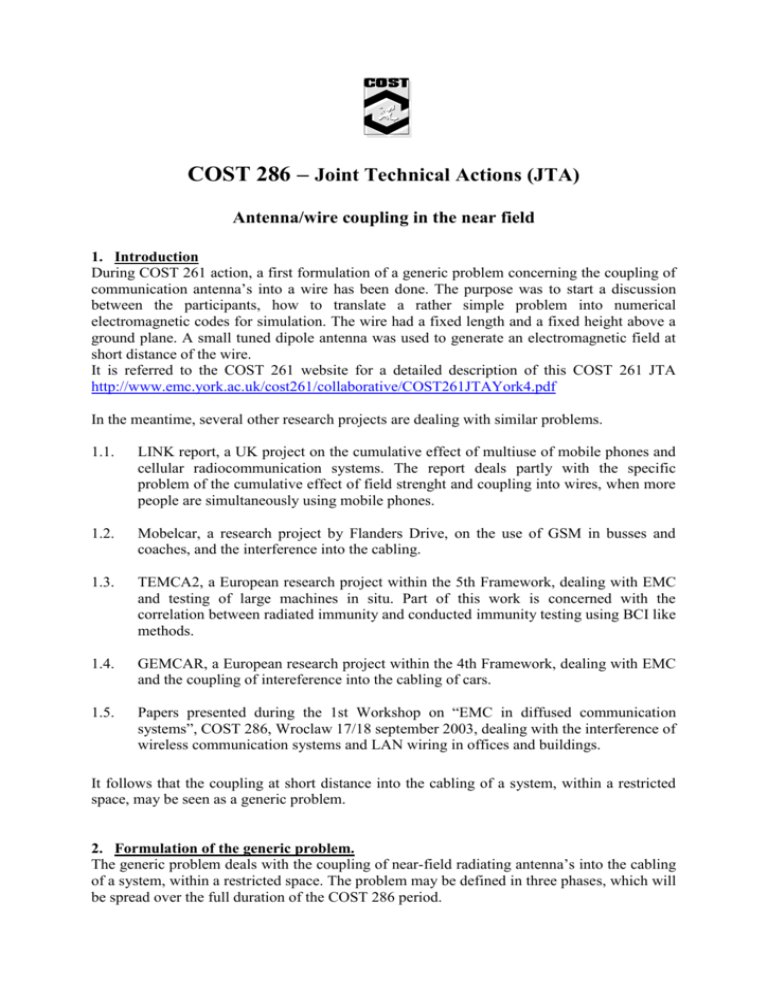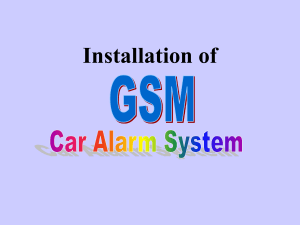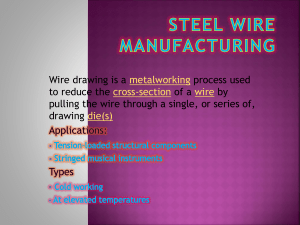Antenna/Wire Coupling in the Near Field
advertisement

COST 286 – Joint Technical Actions (JTA) Antenna/wire coupling in the near field 1. Introduction During COST 261 action, a first formulation of a generic problem concerning the coupling of communication antenna’s into a wire has been done. The purpose was to start a discussion between the participants, how to translate a rather simple problem into numerical electromagnetic codes for simulation. The wire had a fixed length and a fixed height above a ground plane. A small tuned dipole antenna was used to generate an electromagnetic field at short distance of the wire. It is referred to the COST 261 website for a detailed description of this COST 261 JTA http://www.emc.york.ac.uk/cost261/collaborative/COST261JTAYork4.pdf In the meantime, several other research projects are dealing with similar problems. 1.1. LINK report, a UK project on the cumulative effect of multiuse of mobile phones and cellular radiocommunication systems. The report deals partly with the specific problem of the cumulative effect of field strenght and coupling into wires, when more people are simultaneously using mobile phones. 1.2. Mobelcar, a research project by Flanders Drive, on the use of GSM in busses and coaches, and the interference into the cabling. 1.3. TEMCA2, a European research project within the 5th Framework, dealing with EMC and testing of large machines in situ. Part of this work is concerned with the correlation between radiated immunity and conducted immunity testing using BCI like methods. 1.4. GEMCAR, a European research project within the 4th Framework, dealing with EMC and the coupling of intereference into the cabling of cars. 1.5. Papers presented during the 1st Workshop on “EMC in diffused communication systems”, COST 286, Wroclaw 17/18 september 2003, dealing with the interference of wireless communication systems and LAN wiring in offices and buildings. It follows that the coupling at short distance into the cabling of a system, within a restricted space, may be seen as a generic problem. 2. Formulation of the generic problem. The generic problem deals with the coupling of near-field radiating antenna’s into the cabling of a system, within a restricted space. The problem may be defined in three phases, which will be spread over the full duration of the COST 286 period. Phase 1: Wire above a ground plane in open area: simulations and measurements. Phase 2: Enclosure problem: resonances. Phase 3: Wire in an enclosure, and cumulative effect of more sources All phases must be validated by measurements, at least by some of the participants. 2.1. Phase 1: Wire above ground plane in an open area The problem may be formulated by a wire over a ground plane. The system is shown in fig 1. 1, 5, 10 m l 1m -30cm -> l +30cm x = 5 cm 3m 5 → 30/80 cm 150 1,5 m 1m GND plane 12 m The origin of the X-axis is at the source-injection point, and is pointing in the positive direction to the left. Figure 1. Schematic diagram of the wire problem in open area 2.1.1. The antenna is modelled by a tuned dipole, from a 50 Ohm source, 1 Volt. In a second part of this phase, the antenna may be modelled by a type of monopole (so called NOKIA model). Details on this model to be provided by Prof. A. Marvin. 2.1.2. At this moment, only one frequency will be used for both simulations and measurements, namely 900 MHz. 2.1.3. The ground plane used may be chosen to be infinite, or modelled by a grid or another finite ground plane. In the latter case, the plane is 3 m x 12 m. 2.1.4. A wire is laid over the ground plane. The diameter of the wire is taken as 2 mm. The wire is terminated at one end by 150 Ohm and open at the other end. The termination point of 150 Ohm is the reference point of the X-axis. The termination point of 150 Ohm is at 1 m distance from the edge of the finite ground plane. The wire is centered at 1.5/1.5 m above the ground plane in the longitudinal direction. 2.1.5. The termination resistance is taken as 100 Ohm + 50 Ohm. The 50 Ohm stands for the input impedance of the measuring receiver, in case validation measurements will be made. It is clear that the voltage across the grounded 50 Ohm must be calculated. 2.1.6. The position in Y and Z direction is fixed, in that way that the nearest point of the antenna to the wiring is 10 cm above the wire height and 10 cm backwards. The antenna shall be operated for three different polarisations (for H: parallel and perpendicular to the wire). V H 10 cm 10 cm Figure 2. Position of the nearest antenna-tip to the wire 2.1.7. If possible, the current induced in the wire may also be calculated. In any case, the reference or calibration point for this action is with the nearest antenna-tip at X = 0.5m 2.1.8. The wire may vary in the following manner: Height h: 5cm, 30 cm and 80 cm above the ground plane. From 5 upto 30 cm, steps of 5 cm may be introduced Length l: 1, 5 and 10 m length from the termination point Steps by lm may be introduced for more detailed calculations 2.1.9. Apart from the different polarisations, the antenna should be moved from x = - 30 cm upto wire length l + 30 cm. In this way, the antenna may be operated along the full length of the wire, and starting/ending at 1 wavelength away from the wire ending points. 2.1.10. Validating measurements may be done using either a tuned dipole antenna, a monopole or a dummy GSM handheld unit. At the termination point, a 100 Ohm resistor should be placed in series with the input of the receiver. In this way, a 50 Ohm termination is obtained for the Common Mode impedance of the wire. 2.2. Phase 2: Enclosure problem The purpose of this phase is to calculate the resonant effects due to reflections of metal parts and walls of rooms and enclosures. The value of the resonant peaks of the field strength must be compared with the results of an open area, and an type of Q-factor could be defined. 2.3. Phase 3: Wire in an enclosure, and cumulative effect of more sources In phase3 of this JTA, the overall problem of the use of multi mobile phones in an enclosures or a room with respect to the coupling into the wiring will be studied. 3. Deliverables Deadline for phase 1 is set by November 25th, 2004, during the Hamburg workshop. Results must be presented in a tabled format. The results for the antenna reference point (so called calibration point) must be presented separately. Results should be sent to the COST 286 vice chairman: johan.catrysse@khbo.be Version 1.0 – reference: MCM december 4th, 2003, Brussels







